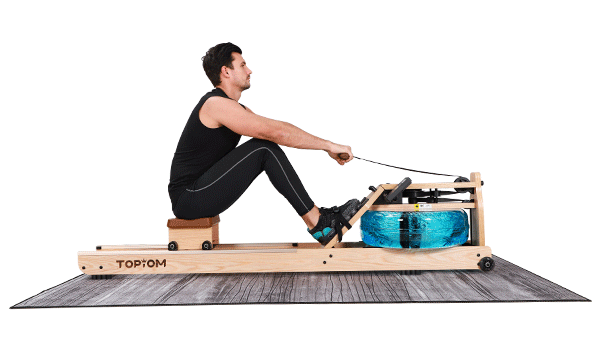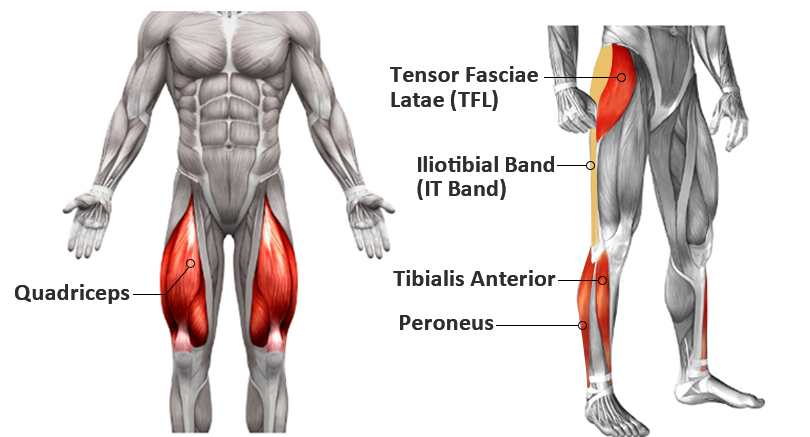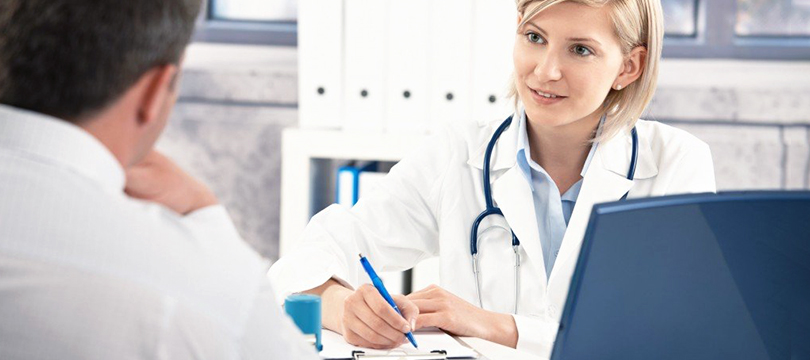The rowing machine helps burn fat, build muscle, and improve aerobic endurance. It is well known as a low-impact exercise machine that offers a great full-body workout. It helps strengthen the muscles around your knee joints, relieve knee pain, and rehab bad knees.
However, only when you do it right. Like all other exercises, overtraining or improper practicing may cause injuries. Knee pain is one of the common injuries of rowers.
Check out the risk factors and easy fixes to keep your knees pain-free in 2023!
Table of Contents
1. Fast Facts about the Knee Joint
2. Rowing Machine Workout and Knee Pain
2.1 Rowing is Low Impact and Easy on the Knee Joint
2.2 Rowing Strengthens the Muscles around the Knee Joint
2.3 Rowing Helps Lose Weight and Reduce Risk of Knee Pain
3. Major Syndromes of Knee Pain in Rowing
3.1 Knee Pain in Rowing – Patellofemoral Syndrome
3.2 Knee Pain in Rowing – Iliotibial Band (ITB) Friction Syndrome
4. Causes and Fixes – Knee Pain in Rowing
4.1 Cause #1: Overtraining
4.2 Cause #2: Over-compression at the Catch
4.3 Cause #3: Hyperextension at the Drive or the Finish
4.4 Cause #4: Improper Footplates Setting
4.5 Cause #5: Improper Foot Stretchers Setting
5. Stretches to Relieve Knee Pain in Rowing
6. DIY Massage to Relieve Your Knee Pain
7. Knee Pain – Prevention Tips
8. Health Reminder
9.The Bottom Line
1. Fast Facts about the Knee Joint
- The knee is the largest and most complex joint in the human body.
- The knee is the joint most commonly affected by arthritis.
- Four ligaments (ACL, PCL, MCL, LCL) connect the femur (thighbone) to the tibia (shin bone),working together to stabilize your knee.
- The knee joins together the thigh bone (femur), shinbone (tibia), the second bone of the lower leg on the outer side of the shin (fibula), and kneecap (patella).
- For every pound you weigh, your knee receives 4 X the amount of stress.
- Participation in sports and recreational activities are risk factors for knee injury.
- Warming up and stretching can prevent knee injuries.
2. Rowing Machine Workout and Knee Pain
It seems that the motion of rowing is primarily at the knees. You might worry about developing or exacerbating knee pain. In fact, rowing is easy on your knee joints and non-weight bearing. And in some instances, it helps bad knees.
“The benefits of rowing are unquestionable. There aren’t many forms of exercise that act as a low impact total body workout that dramatically improves weight loss as well as muscle and joint mobility.”
–Thomas Fitzgerald, Head PT at fitness studio chain F45
2.1 Rowing is Low Impact and Easy on the Knee Joint
Unlike popular workout routines such as running or cycling, rowing is a smooth, rhythmic motion that is much safer for giving yourself a good full-body workout.
Thanks to the position of the body. The entire workout is done seated. When you row properly and maintain a relaxed body posture, you are at the lowest risk of feeling a negative impact, unlike the resistance integral to running.

2.2 Rowing Strengthens the Muscles around the Knee Joint
Rowing is good for your knees in that it strengthens the muscles around your knee joints. Stronger muscles help provide better support to the joints.
When you row, your quadriceps above the knee extend. Your hamstrings and gastrocnemius muscles also flex with contractions. These muscles grow stronger as you row. As a consequence, they can support your knee joint more effectively and prevent knee pain.
2.3 Rowing Helps Lose Weight and Reduce Risk of Knee Pain
An additional advantage of the rowing machine is that it helps you burn serious calories and lose weight. Thus reduce the risk of knee pain.
The rowing machine is an incredible fat burner. Because it engages all the major muscle groups, including legs, arms, back, abdominals, and buttocks. Naturally, more energy is needed for your body to move every pound of your muscle tissue. When you supplement rowing with a proper diet, it will boost your weight loss by providing a significant calorie burn.
The Harvard Health Publications made a research on the calories burned in 30 minutes by activity and weight. A glimpse of the rowing activity is provided below.
Calories Burned in 30-Minute Activities
| Gym Activities | 125-pound person | 155-pound person | 185-pound person |
|---|---|---|---|
| Rowing, Stationary: moderate | 210 cal | 252 cal | 294 cal |
| Rowing, Stationary: vigorous | 255 cal | 369 cal | 440 cal |
Carrying excess weight puts extra stress on your knees, which may lead to osteoarthritis. In this case, you’ll get relief from knee pain by losing weight as you row.
Before starting your weight loss regime with a rowing machine, check our blog post here to have a more comprehensive understanding of weight loss. If the stubborn belly fat is bothering you, follow us to know the science behind losing belly fat with a rowing machine. You’ll avoid detours and get the desired results faster!
3. Major Syndromes of Knee Pain in Rowing
Rowing is an excellent way of improving your fitness when you do it right. However, twisting the knee, irritating the muscles at the kneecap, straining tendons or ligaments may contribute to different conditions of knee pain resulted from indoor rowing.
The two major syndromes of knee pain can include patellofemoral pain syndrome and iliotibial band friction syndrome.
3.1 Knee Pain in Rowing – Patellofemoral Pain Syndrome
Patellofemoral pain syndrome (PFPS) happens behind or around your kneecap and can travel to your thigh or shin.
You may experience a clicking sensation in the knee when rowing. The pain usually becomes apparent when walking up or down stairs. It becomes more severe when you carry out training activities such as squat jumps and squats. Because your kneecap (patella) doesn’t run smoothly against your leg (femur).
The pain is very common among athletes such as runners and cyclists.
Treatment:
Stretching and strengthening to correct muscle imbalance around your knee can improve alignment and movement. Besides, rest and anti-inflammatory medications, such as ibuprofen and naproxen sodium may help.
3.2 Knee Pain in Rowing – Iliotibial Band (ITB) Friction Syndrome
Another fairly common knee pain experienced by rowers is iliotibial band friction syndrome (ITBFS). The iliotibial band (ITB) glides over the outside of the knee as it bends. And repetitive exercise may cause inflammation and localized pain at the outside of your hip or knee. These are the major symptoms of ITB friction syndrome.
Treatment:
ITB stretching, rest, ice, taping, and strengthening of the gluteal muscles may help.
4. Causes and Fixes – Knee Pain in Rowing
Although knee pain caused by rowing machines may be the result of many different conditions, the major risk factors can be considered into several categories. They are overtraining, wrong rowing technique, and improper rowing machine setting.
If you want to reap the rich benefits of rowing machine workouts free from knee pain, check out these causes and fixes to help you row safely and pain-free!
4.1 Cause #1: Overtraining
Overuse or overtraining is the commonest cause of knee pain, back pain, and butt pain resulted from rowing machine workouts.
Rowers are known for their competitive nature and total dedication to their sport. Too much training, however, may cause minor overuse injuries like strains, sprains, and fatigue. More seriously, it will lead to major chronic knee injuries. Because you’re irritating the muscles at the kneecap and straining tendons or ligaments.
Easy fix:
Don’t overexert yourself when you’re first starting out. Even when you progress and get used to it, don’t overtrain. In order to avoid physical problems, stop exercising when you’re too tired to maintain proper form.
Besides, mix it up with other sports like swimming, cycling, yoga… Since just rowing may put too much strain on the muscles needed to row.
In this way, you can continue to enjoy rowing, free of excessive pressure and burnout.
4.2 Cause #2: Over-Compression at the Catch
Over-compression of your legs is one of the main contributors to rower’s knee pain or problems. It happens when your knees go past the ankles.
During the catch phase (the starting position of a stroke), your knees are in a flexed position. If you overcompress your legs at the catch, this will result in a smaller knee angle (the angle between your upper and lower leg). In this case, straining of the muscles surrounding the knees or compression of the kneecap may occur. Over time it will lead to knee problems like patellofemoral stress syndrome, or iliotibial band syndrome.
Besides, over-compression makes your catches less effective and gets in the way of being fast. Because overcompression will lead to an excessive stretch of tendons. Hence your muscles need to work overtime to come back from this overstretched position.
Easy Fix:
The optimal leg compression is about “knees over ankles”. Your heels might lift up a little bit in this position. Stop forward motion when your shins reach vertical (your knees are right over the ankles). It helps limit knee flexion at the catch phase and avoid over-compression.
The image below shows a very good catch position:
If you’re a novice, it’s helpful for you to avoid over-compression by reducing the load on your knees. Lower the resistance level to make loads lighter.
4.3 Cause #3: Hyperextension at the Drive or the Finish
The most serious injuries happen from hyperextension, at the end of the drive phase and the finish phase. In order to get length in the stroke, you might be inclined to fully extend your leg, resulting in hyperextension of your leg.
Unfortunately, hyperextension is a weak position. As you hyperextend your knees, your knees are locked. The power is lost in this case and you don’t perform an effective stroke. Because your leg muscles are not fully engaged. Even worse, it puts a lot of pressure on your knee. Day by day, your knee gets injuried.
Easy Fix:
For best results, you should always keep your knees at least slightly bent to ensure that the muscles stay engaged.
When you start leaning your trunk back at the end of the drive phase, keep a few degrees of bend in your knees and a bit of plantar flexion at the ankle to prevent hyperextension of your knee joints.
Watch your form and stay aware of the common rowing machine mistakes and the potential for injury. The wrong rowing technique can end up exacerbating your condition rather than improving it. Mastering the correct rowing technique is always important to help you get started and achieve results without risking injury.
For a more comprehensive guide, check out our blog post: indoor rowing technique 101. A complete step-by-step guide including rowing form, breathing, power exertion, and stroke timing is provided.
4.4 Cause #4: Improper Foot Placement
Poor foot posture will contribute to the malalignment of your kneecap. Improper foot placement will not only affect your comfort and rowing form but also cause knee pain or problems.
Placing your feet too low will cause improper leg drive and a weak power position. Such poor biomechanics will be repeated with each stroke and lead to malalignment of the patella and patellofemoral pain. Besides, this will also put added stress on your lower back.
Besides, wearing improper indoor rowing shoes can affect your foot placement, form, comfort, and power.
Easy fix:
Make sure your feet are at a comfortable angle to each other as you look at them. There should be roughly the same angle between your feet when they are strapped to the rowing machine as when you are standing comfortably.
Having the “flat bottom” is a very important feature for indoor rowing shoes. In addition, there should be very little “heel-to-toe-drop”. Generally speaking, your feet should be at a 45 degree angle when they are properly placed on the footboard. Because rowing has a very low impact on your feet and ankle joints, too much cushioning may lead to a less efficient stroke. The flat-soled shoes allow for the optimal foot position while rowing. Except for flat shoe, a pair of good indoor rowing shoes should be flexible, comfortable, breathable, and lightweight.
4.5 Cause #5: Improper Foot Straps Setting
When you don’t strap your feet in the rowing machine properly, you are inclined to twist your knee, which will cause further knee pain or a stress fracture on your ankle from the strap.
Easy fix:
The foot straps should go over the ball of your feet (the widest part of your foot right beneath your toes).
Try the feet out rowing drill. Rowing feet out means you set yourself free from the foot straps. In this case, you need to adopt proper rowing technique to stay connected throughout the stroke without the “crutch” of the straps. This video shows you exactly how to do it, and how it will make you a merrier rower.
5. Stretches to Relieve Knee Pain in Rowing
Stretching is a nice passive recovery for you to avoid or alleviate rowing machine knee pain. It’s very beneficial as it gives those muscles which really working so hard a little bit of passive stretching. It brings blood flowing to your muscles and joints and increases your range of motion. Your tendons, ligament and muscles will become elastic as well.
Focus on stretching the quadriceps, hamstrings, calves, glutes, hip flexors, and the IT band post rowing to prevent or relieve knee pain. Check out the 10 best knee stretches to help relieve knee pain.
Caution: It’s helpful to take a little time to stretch daily. But remember to warm up your body before practicing, especially in cold weather and in the early morning or at the start of your day.
6. DIY Massage to Relieve Your Knee Pain
Use a foam roller or massage gun to do a deep tissue massage for the muscles around your knee. This is often adopted by physical therapists to relieve knots in muscles and soft tissues.
You can give yourself a soothing massage to release the muscles and tendons that lie around your knee, including your quadriceps in the front of your thigh; the Tensor Fasciae Latae, or TFL, which lies near the top of your hip; and the Tibialis Anterior and Peroneus, which lie down your shin; the Iliotibial Band, or IT Band, which runs along the outside of your leg from the hip to the knee and shinbone.

This will improve your knee function and flexibility, lower existing pain, and prevent any increase in knee pain.
Find How to foam roll for Knee pain here.
7. Knee Pain – Prevention Tips
The fixes, stretches, and massage can help relieve knee pain easily. However, to maintain their effect, you can incorporate the following tips into your lifestyle. They will also help in keeping your knees healthy and pain-free.
- Maintain a healthy weight.
- Wear proper fitting shoes.
- Warm up before you exercise.
- Indulge in low-impact exercises.
- Do some yoga.
- Drink more water.
- Follow a healthy nutritious diet.
- Do not sit for too long.
- Do not decrease your physical activity.
8. Health Reminder
Exercise should never cause pain or make it worse. Remember: Muscle soreness after a hard workout is completely normal, it is a side effect of the stress put on muscles when you exercise. Generally, knee stretches and massages can help muscle soreness.
If your knee aches while rowing, firstly check your rowing machine setting. Then, focus on improving your posture during the workout. Also, supplement your rowing with stretches that relieve the tension and pain in the muscles around your knee joint.
It is important to stop rowing immediately if you feel sharp, shooting, or sudden pain in or around your knee joints. Check with your doctor as soon as possible in order to prevent the injury from becoming worse.
If you have chronic knee pain, talk to your physician or doctor before trying any new exercise to avoid further knee injuries.

The Bottom Line
Rowing is an excellent way of improving both your physical and mental fitness. And I really hope that you stay pain-free while working out on the rowing machine.
Merrily, merrily, merrily, merrily… let’s row to a healthier and happier life!









